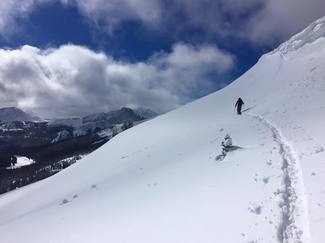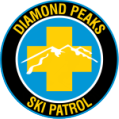History of Diamond Peaks Ski Patrol

The Diamond Peaks Ski Patrol began as a backcountry education, emergency care, and rescue organization during the 1990-1991 season. The winter-use area (Cameron Pass) served by the patrol is located 65 miles west of Fort Collins, Colorado on State Highway 14. Characteristics of the winter use area demanded a unique patrol that was not originally defined by the National Ski Patrol.
Types of NSP Patrols
Two distinct types of ski patrols were recognized by the NSP:
How Diamond Peaks Patrol Differed From the Standard Type of NSP Patrols
Diamond Peaks had unique characteristics that fit neither the typical Alpine nor Nordic definition described by the NSP. We have.
Developing a New Type of Patrol
Negotiations with the U.S. Forest Service (USFS) to establish a new patrol were started in the spring of 1990 by Ron Splittgerber. This followed an announcement that the National Park Service (NPS) was closing Hidden Valley Ski Area in the Rocky Mountain National Park. Many former members of the patrol at Hidden Valley dual-registered with the Lake Eldora patrol, and the newly formed Diamond Peaks Patrol (DPSP). Most of the first aid and rescue equipment owned by the Hidden Valley patrol was designed for Alpine ski areas, and as a result was donated to the Lake Eldora and Medicine Bow patrols. This left the new DPSP patrol with no equipment, and several aging radios that were not compatible with the radio service. Splittgerber negotiated an agreement with the USFS covering liability, worker's compensation and use of government radios and agreed on the trails to be patrolled in the Cameron Pass area for the patrol. This agreement served as the basis for several other patrol negotiations with the USFS in the Rocky Mountain Division of the NSP.
During DPSP's first two seasons, the patrol served as a volunteer organization under the law enforcement arm of the USFS. During the 1992-93 season, the Forest Service created Volunteer Coordinator position. DPSP then coordinated its activities with this volunteer coordinator, an arrangement that continues today. During the 2000-2001 season, the patrol was awarded a generous grant from Jeff Lebesch (co-owner of the New Belgium Brewing Company in Fort Collins, CO.) This donation immeasurably increased the patrol's training and rescue abilities. The funds allowed the purchase of a laptop computer, digital projector for presentations and numerous snow and rescue tools.
Through the first decade of its existence, DPSP provided public education in avalanche hazards and mountain travel to well over 600 members of the public, sold (at wholesale) over 150 avalanche transceivers, and assisted on several search and rescue missions. Patrollers also relay snow information to the Colorado Avalanche Information Center (CAIC) for current snow conditions in the northern mountains.
The current roster is built on 25+ dedicated patrollers/instructors, plus many other people who maintain interest and support. Contributions of the patrol are immeasurable (ranging from first aid services to mechanical repair to avalanche hazard evaluation to search/rescue). In just two seasons, DPSP provided first aid training for 15 new patrollers and basic avalanche awareness training for 200 people.
The Diamond Peak Ski Patrol philosophy is based on doing whatever it takes to build an educated and safe population of snow enthusiasts.
Types of NSP Patrols
Two distinct types of ski patrols were recognized by the NSP:
- Ski areas that were served by lifts (Alpine). These are characterized by patrollers using downhill skis, Cascade toboggans with first-aid gear, and strict schedules.
- A ski area with maintained terrains normally not served by lifts. These were called Nordic Patrols and served by patrollers on light touring or skate skis.
How Diamond Peaks Patrol Differed From the Standard Type of NSP Patrols
Diamond Peaks had unique characteristics that fit neither the typical Alpine nor Nordic definition described by the NSP. We have.
- No lifts, but a vertical elevation comparable to many Alpine ski areas
- Over 100 miles of trails not maintained on a regular basis
- No phone and marginal emergency radio communications
- Over one-hour drive to nearest medical facility
- Public use numbers comparable to a small Alpine area
- Several high-use areas with extreme avalanche danger
- No commercial ski facilities
- Use of Norpine equipment (Alpine type skis, heavy boots, adjustable poles.)
- Requirement to carry full packs with emergency gear
- Develop unique training such as building an emergency toboggan using victim's skis, back country search techniques and avalanche rescue procedures
- Snow survey and avalanche hazard understanding
- Coordination with local ambulance service and county search and rescue group
- Utilizing car as rescue cache for oxygen pack and other supplies
- Developing skills in education to teach classes in avalanche and mountain safety
Developing a New Type of Patrol
Negotiations with the U.S. Forest Service (USFS) to establish a new patrol were started in the spring of 1990 by Ron Splittgerber. This followed an announcement that the National Park Service (NPS) was closing Hidden Valley Ski Area in the Rocky Mountain National Park. Many former members of the patrol at Hidden Valley dual-registered with the Lake Eldora patrol, and the newly formed Diamond Peaks Patrol (DPSP). Most of the first aid and rescue equipment owned by the Hidden Valley patrol was designed for Alpine ski areas, and as a result was donated to the Lake Eldora and Medicine Bow patrols. This left the new DPSP patrol with no equipment, and several aging radios that were not compatible with the radio service. Splittgerber negotiated an agreement with the USFS covering liability, worker's compensation and use of government radios and agreed on the trails to be patrolled in the Cameron Pass area for the patrol. This agreement served as the basis for several other patrol negotiations with the USFS in the Rocky Mountain Division of the NSP.
During DPSP's first two seasons, the patrol served as a volunteer organization under the law enforcement arm of the USFS. During the 1992-93 season, the Forest Service created Volunteer Coordinator position. DPSP then coordinated its activities with this volunteer coordinator, an arrangement that continues today. During the 2000-2001 season, the patrol was awarded a generous grant from Jeff Lebesch (co-owner of the New Belgium Brewing Company in Fort Collins, CO.) This donation immeasurably increased the patrol's training and rescue abilities. The funds allowed the purchase of a laptop computer, digital projector for presentations and numerous snow and rescue tools.
Through the first decade of its existence, DPSP provided public education in avalanche hazards and mountain travel to well over 600 members of the public, sold (at wholesale) over 150 avalanche transceivers, and assisted on several search and rescue missions. Patrollers also relay snow information to the Colorado Avalanche Information Center (CAIC) for current snow conditions in the northern mountains.
The current roster is built on 25+ dedicated patrollers/instructors, plus many other people who maintain interest and support. Contributions of the patrol are immeasurable (ranging from first aid services to mechanical repair to avalanche hazard evaluation to search/rescue). In just two seasons, DPSP provided first aid training for 15 new patrollers and basic avalanche awareness training for 200 people.
The Diamond Peak Ski Patrol philosophy is based on doing whatever it takes to build an educated and safe population of snow enthusiasts.
